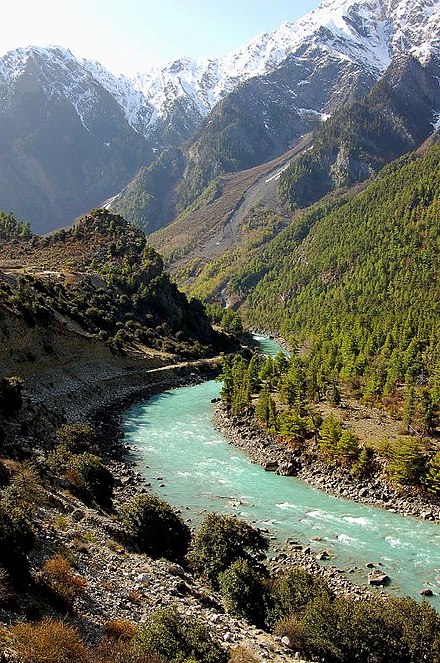Nyang River
The Nyang River (Tibetan: ཉང་ཆུ, Wylie: nyang chu; Chinese: 尼洋曲; pinyin: Niyang qu; also transliterated as Niyang or Nanpan) is a major river in south-west Tibet and the second largest tributary of the Yarlung Tsangpo River by discharge.

The Nyang has a length of 307.5 km and originates at 5,000 meters above the sea level from the Cuomuliangla in the Goikarla Rigyu, west of the Mila Mountain. The river joins the Yarlung Tsangpo in Cemeng, Nyingchi, 2,580 meters below its source.[1] Its largest tributary is the Ba River. It flows past the town of Bayi where it is crossed by the Bayi Zanchen bridge.[2]
The Nyang River valley has an area of 24,800 km2, including 175,700 mǔ (117 km2) of cultivated land, 209,800 mǔ (140 km2) of usable wasteland, 24.75 million mǔ (16,500 km2) of forestry land, and 12 million mǔ (8,000 km2) of usable grassland. It is also reported to contain 1,500 kinds of wild animals and plants, 310,000,000 million m³ of wood reserves and 18 million kw of hydroenergy resources.[3]
See also
Footnotes
- ^ Nyang river information published on www.tibet.cn, visited August 4, 2007.
- ^ Dorje (1999), p. 236.
- ^ Comprehensive Development of Agriculture in Niyang River Valley, Beijing Office of the People's Government of Tibet Autonomous Region, visited August 4, 2007
References
- Dorje, Gyume. (1999). Footprint Tibet Handbook with Bhutan. 2nd Edition. Footprint Handbooks, Bath, England. ISBN 1-900949-33-4.
29°26′01″N 94°29′04″E / 29.4337°N 94.4844°E / 29.4337; 94.4844
